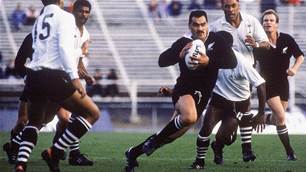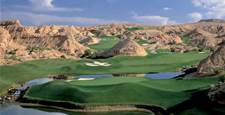We have all read stories about golf courses, whether they are in Australia or abroad, and the author has dubbed said layout a ‘hidden gem’.
We have all read stories about golf courses, whether they are in Australia or abroad, and the author has dubbed said layout a ‘hidden gem’. I know I have given a few courses this tag over the years and you are about to read it again.
This time it is, ironically, for a golf course that lies only a few kilometres from the heart of Melbourne’s world famous Sandbelt and some of Australia’s premier golf courses. While Patterson River Country Club might be located on the southern fringe of the Sandbelt, it is a course few outside the surrounding area might know about.
“We’re not very well known, especially outside Melbourne,” Patterson River Country Club General Manager Pam Carpenter says.
“In fact, there are golfers living in adjoining suburbs that probably don’t know we’re here,” she laughs. “But that is changing and more golfers are discovering we’re here and that the course has improved a lot over the past few years.”
Golf has been played on the site of the present course since 1925 when farmland was transformed into an 18-hole course designed by Brit Gordon Oliver, who would later create other Melbourne courses Long Island and Green Acres. The land owners, the Priestly family, gave Oliver a sizeable parcel of land to work with but the soil beneath was not ideal, but more about that later. Oliver routed the private course, which was named Gleneagles.
For more than 20 years, the course was enjoyed by golfers who would catch the train to nearby Carrum railway station and catch a ride on the horse and jinker transfer to the course. In 1948, members of the club purchased the course from the Priestlys and the name was changed to Patterson River Country Club, after the river which flowed along its southern boundary, and became a members-only club.
The late 1990s saw a major shift in the direction of the club. Moves were made to sell off some of the land occupied by the course, nearest Patterson River, for real estate development. This development deal was used to finance a five-year master-plan to completely redesign the course, which had been criticised for years for not coping well with wet weather. This was a throwback to the fact the course was originally built on farmland dominated by heavy, clay-like soils.
Pacific Coast Design course architect Phil Ryan was commissioned to create a master-plan for the site and it was soon discovered that there was quality ‘Sandbelt’ sand to be found beneath the heavy topsoil. The master-plan work was conducted in two phases and, throughout, major earthworks were carried out to extract the soil, create a 15-hectare lake system and then shape parts of the new course with high and subtle mounding. Dozens of pines and other introduced tree species were removed and replaced with indigenous trees.
With the sand brought to the surface, Ryan was able to craft his version of Sandbelt bunkering, which features extensively in different sizes and shapes throughout the layout. Raising the sand also created a far better draining course that can now be played all year round.
Ryan’s layout officially opened for play in May 2005 and its couch fairways and large Pennlinks bentgrass greens have matured beautifully in the years since.
During this period the club also decided to open up the course to more public play and, today, visiting golfers can tread Patterson River’s fairways and greens six days a week.
Having seen the course in the late 1990s I was pleasantly surprised with the transformation that has occurred at Patterson River. Ryan has designed a layout that offers plenty of width from the tee and, on most holes, there are a number of different playing lines to attack a green. While there is plenty of water to be found around the course (it can be seen on 14 of the 18 holes) it rarely comes into play for straight or conservative hitters. Lakes flank several holes but there are only two forced water carries, and both come on par-3s (the 166-metre 2nd and 132-metre 12th) yet a mid-iron is all that is required to find land beyond the hazard.
One hole where water will have an effect on the aggressive player is the 481-metre par-5 6th hole, which is the first of a trio of holes I reckon are the pick of the front nine. The fairway here doglegs gently right and features a pond on the inside of the bend that is easily reached from the tee. But if you have visions of hitting this green in two blows you will need to flirt with the water and shorten the journey by taking a playing line down the right half of the fairway. If you succeed in carrying the edge of the water, a straight hit to a wide front green lies ahead.
In my opinion, the 157-metre 7th is Patterson River’s best par-3. The surface of the green is slightly higher than the tee so one extra club is required to cover the distance here and avoid falling short into sand to the right or seeing your ball deflected down a well-trimmed slope into rough to the left. The two-tiered green also has some subtle breaks that can be hard to read for the newcomer.
The short par-4 8th is the most heavily bunkered hole on the course and is perhaps the most interesting of the sub-350-metre par-4s at Patterson River. The slight dogleg left features two large bunkers on the right edge of the fairway to catch shorter hitters, while a lone 8-shaped sand trap about 50 metres short of the green and on the left of the fairway will nab the long hitter going at the green with their driver. Keep your tee shot on the fairway here and the approach shot to the slightly raised green is an easy one.
Conservative play is also a pre-requisite for making pars and birdies on the dogleg right 311-metre par-4 11th. With water narrowing the landing area considerably from the left, any player who attacks this hole needs to turn their tee shot from left to right to avoid hitting into the lake. The green here is massive with just two deep pot bunkers (that are vastly different in style to the remainder of the course’s bunkers) cut into the right fringe – one near the front and the other towards the back.
Patterson River also boasts a strong quartet of finishing holes from the 423-metre par-4 15th demanding strength and accuracy, while the 507-metre par-5 closing hole might appear as though it can be overpowered but the better scores will come from a good strategy. A lake flanks the entire left side of the hole but lies well wide of the fairway. The real danger here is the sand – three enormous bunkers that crowd the final approach into the green. Going for the green here in two shots is fraught with danger and more birdies will come by laying up short of the left bunker (50 metres short of the green) and firing a short iron into the heart of the putting surface. I might be a little biased here having birdied it during my visit but I think this par-5 is the best of the four on offer at Patterson River.
I really enjoyed playing Patterson River. The design was certainly a huge improvement on the ‘boggy’ course I had played back in the late 1990s and, for a layout that gets plenty of public players, the conditioning was superb. While some freezing cold mornings had started to snap the colour out of the fairways, the playing surfaces throughout were very good.
So the term ‘hidden gem’ might not apply to Patterson River for too much longer. The secret is bound to get out sooner rather than later.
Related Articles

International Spotlight: Omanu Golf Club

Celebrity Kiwi couple tee off in paradise













